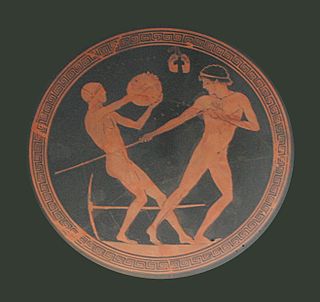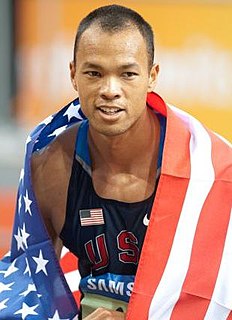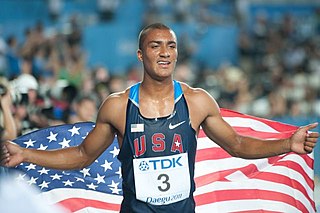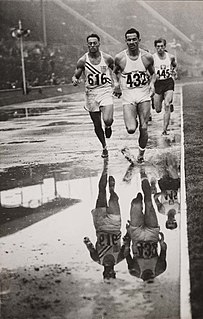Related Research Articles

A pentathlon is a contest featuring five events. The name is derived from Greek: combining the words pente (five) and -athlon (competition). The first pentathlon was documented in Ancient Greece and was part of the Ancient Olympic Games. Five events were contested over one day for the Ancient Olympic pentathlon, starting with the long jump, javelin throwing, and discus throwing, followed by the stadion and wrestling. Pentathletes were considered to be among the most skilled athletes, and their training was often part of military service—each of the five events in the pentathlon was thought to be useful in war or battle.

Paavo Ilmari Yrjölä, also known as the Bear of Hämeenkyrö, was a Finnish track and field athlete who won the gold medal in the decathlon at the 1928 Summer Olympics. He also competed in shot put and high jump at the same Games, and in decathlon in 1924 and 1932, but less successfully.

Daniel Dion O'Brien is an American former decathlete and Olympic gold medalist. He won the Olympic title in 1996, three consecutive world championships, and set the world record in 1992.

John Carlyle "Johnny" Garrels was an American athlete who excelled in the 110 metres hurdles, discus throw, shot put, and as a fullback and end in American football.

Bryan Ezra Tsumoru Clay is an American decathlete who was the 2008 Summer Olympic champion for the decathlon and was also World champion in 2005.

Akilles "Aki" Eero Johannes Järvinen was a Finnish decathlete. He competed at the 1928, 1932 and 1936 Olympics and won two silver medals, in 1928 and 1932; he served as the Finnish flag bearer at all three games. He also won a European silver medal in the 400 m hurdles in 1934.

Kinue Hitomi was a Japanese track and field athlete. She was the world record holder in several events in the 1920s – 1930s and was the first Japanese woman to win an Olympic medal. She was also the first woman to represent Japan at the Olympics.

William Delouis Watson, also known as Big Bill Watson, was an American track and field athlete. Watson was the Amateur Athletic Union (A.A.U.) decathlon champion in 1940 and 1943. He was the first African-American to win the U.S. decathlon championship and the first African-American to be selected as the captain of any athletic team at the University of Michigan, being selected as the captain of the Michigan track team in 1939. While at Michigan, Watson won 12 individual Big Ten Conference championships, including three consecutive championships (1937–1939) in the long jump, discus and shot put. He served as a police officer for the Detroit Police Department for 25 years from the early 1940s until his retirement in 1966. Watson was posthumously inducted into the University of Michigan Athletic Hall of Honor in 1982.

John Kenneth Doherty was an American decathlon champion, college track and field coach, author and longtime director of the Penn Relays. While a student at the University of Michigan, Doherty won the American decathlon championship in 1928 and 1929 and won the bronze medal in the event at the 1928 Summer Olympics in Amsterdam. He later served as a track coach at Princeton University (1929–1930), the University of Michigan (1930–1948), and the University of Pennsylvania (1948–1957). He was also the meet director for the Penn Relays from 1956 to 1969 and of the first dual track meet between the United States and the Soviet Union in 1959. He was also a published author of works on track coaching, and his Track & Field Omnibook was regarded as "the track coach's bible" from the 1970s through the 1990s. Doherty has been inducted into at least six athletic halls of fame, including the National Track and Field Hall of Fame and athletic halls of fame at the University of Pennsylvania, University of Michigan, and Wayne State University.

Ashton James Eaton is a retired American decathlete and two-time Olympic champion, who holds the world record in the indoor heptathlon event. Eaton was the second decathlete to break the 9,000-point barrier in the decathlon, with 9,039 points, a score he bettered on August 29, 2015, when he beat his own world record with a score of 9,045 points, and remains the only person to exceed 9000 points twice. His world record was broken by Frenchman Kevin Mayer on September 16, 2018 with a total of 9,126 points, who became the third man to pass the 9,000-point barrier.

The USA Track & Field Outdoor Championships is an annual track and field competition organized by USA Track & Field, which serves as the American national championships for the sport. Since the year 1992, in the years which feature a Summer Olympics, World Athletics Championships or an IAAF Continental Cup, the championships serve as a way of selecting the best athletes for those competitions.

The Michigan Wolverines men's track and field team is the intercollegiate track and field program representing the University of Michigan. The school competes in the Big Ten Conference in Division I of the National Collegiate Athletic Association (NCAA).

The men's 400 metres hurdles event at the 1928 Olympic Games took place between July 29 & July 30. There were 25 athletes from 13 nations. The maximum number of athletes per nation was 4. The event was won by David Burghley of Great Britain, the first time a hurdler not from the United States had won. Americans Frank Cuhel and Morgan Taylor took silver and bronze. Taylor, who had been the defending champion, was the second man to win multiple medals in the 400 metres hurdles.

Philip Roy Mulkey is an American track and field athlete, primarily known for the multi-event decathlon. Mulkey was the second place American behind Rafer Johnson at the 1960 USA Outdoor Track and Field Championships which served as Olympic Trials. He failed to finish the 1960 Olympic competition, dropping out after the discus throw. Mulkey had been a competitor at the 1952 Olympic Trials finishing 17th as a high schooler from Purdy, Missouri and the 1956 Olympic Trials finishing 7th representing the University of Wyoming.
Brittany Borman is an American track and field athlete who competes primarily in the discus and the javelin throw. She is a four-time NCAA Track and Field Champion, winning the javelin in 2010, 2011, and 2012, and the discus in 2010. In 2012, she won the US Olympic Trials in the javelin and represented the United States at the 2012 Summer Olympics. She also represented the US at the 2016 Olympic Games.

Combined events at the Summer Olympics have been contested in several formats at the multi-sport event. There are two combined track and field events in the current Olympic athletics programme: a men's decathlon and a women's heptathlon.
Jeff Bennett is a native of Vinita, Oklahoma. He is an American former decathlete who competed in the 1972 Summer Olympics.
The 1932 United States Olympic trials for track and field were held on July 15 and July 16, 1932 and decided the United States team for the 1932 Summer Olympics in Los Angeles. The trials for men and women were held separately; men competed in Stanford Stadium in Stanford, California, while women competed in Dyche Stadium in Evanston, Illinois. Both meetings also served as the annual United States outdoor track and field championships. For the first time, only the top three athletes in each event qualified for the Olympics; until 1928, every nation had been allowed four entrants per event.
The 1936 United States Olympic trials for track and field were held in July 1936 and decided the United States team for the 1936 Summer Olympics in Berlin. The trials for men and women were held separately; men's events were held at Randall's Island Stadium in New York City on July 11 and July 12, while women competed at Brown Stadium in Providence, Rhode Island on July 4. The top three athletes in each event qualified for the Olympic Games. The women's meeting also served as the annual outdoor track and field championships of the Amateur Athletic Union (AAU); the men's AAU championships were held separately a week before the Olympic trials.

Anne Marie Vrana O'Brien was an American sprinter. She represented the United States at the 1928 Summer Olympics in the 100 meters and at the 1936 Summer Olympics in the 80-meter hurdles. In 1932 she equaled the 80-meter hurdles world record, but fell at the Olympic Trials and missed the Olympics.
References
- 1 2 3 4 5 6 7 8 9 10 11 12 13 14 15 16 17 18 19 20 21 22 23 24 25 26 Hymans, Richard (2008). "The History of the United States Olympic Trials – Track & Field" (PDF). USA Track & Field . Retrieved October 20, 2015.
- 1 2 3 4 5 6 7 8 9 "Report of the American Olympic Committee" (PDF). American Olympic Committee/LA84 Foundation. 1928. Retrieved October 24, 2015.[ permanent dead link ]
- 1 2 "Final Olympic Tryouts To Start Tomorrow". The Pittsburgh Press . July 2, 1928. Retrieved October 25, 2015.
- 1 2 3 4 Zarnowski, Frank. "History of the Decathlon at U.S. Olympic Trials" (PDF). Retrieved October 25, 2015.
- 1 2 3 "Taylor Races Over Hurdles To World's Record". Chicago Tribune . July 5, 1928. Retrieved October 25, 2015.
- 1 2 3 4 5 6 Hymans, Richard; Matrahazi, Imre. "IAAF World Records Progression" (pdf) (2015 ed.). International Association of Athletics Federations . Retrieved October 20, 2015.
- 1 2 "12 Track Athletes Selected At 'Philly' For Olympic Team" (PDF). The Binghamton Press . July 5, 1928. Retrieved October 25, 2015.
- ↑ Gould, Alan (Associated Press) (July 6, 1928). "Excellent Crop of Track and Field Talent Boosts Hopes". St. Petersburg Times . Retrieved October 25, 2015.
- ↑ "Schuylkill College Wins Race at Penn Relay Carnival". Reading Eagle . April 29, 1928. Retrieved October 25, 2015.
- 1 2 Currie, George (July 15, 1928). "Frank Hussey's Escapade Has Relieved Threatening Situation" (PDF). Brooklyn Daily Eagle . Retrieved October 24, 2015.
- 1 2 "Elkins Not Included On U.S. Decathlon Squad". Reading Eagle . July 17, 1928. Retrieved October 24, 2015.
- 1 2 3 Vosburgh, F.G. (Associated Press) (July 28, 1928). "'Olympic Team That Was Left Behind' Refuses To Stay Home". The Daily Illini . Retrieved October 24, 2015.
- 1 2 Jukola, Martti (1935). Huippu-urheilun historia (in Finnish). Werner Söderström Osakeyhtiö.
- ↑ "Martin, Purdue Runner, Trods Path To Fame". Chicago Tribune . April 21, 1929. Retrieved October 26, 2015.
- ↑ Hodak, George A. "An Olympian's Oral History: Ernest "Nick Carter"" (PDF). LA84 Foundation. Archived from the original (PDF) on August 19, 2016. Retrieved October 26, 2015.
- 1 2 3 Walsh, Davis J. (INS) (July 11, 1928). "America's Newest Army Of Expedition Sets Sail For Amsterdam Olympiad". Indiana Gazette . Retrieved October 26, 2015.
- ↑ "Wightman Quits Olympic Body". Reading Eagle. July 11, 1928. Retrieved October 26, 2015.
- ↑ Currie, George (July 12, 1928). "300 Athletes Who Sailed For Amsterdam Comprise "Best Team Ever Sent"" (PDF). Brooklyn Daily Eagle. Retrieved October 26, 2015.
- 1 2 3 4 Gould, Alan (Associated Press) (July 8, 1928). "World, Olympic, National Marks Broken at Harvard". Daily Illini. Retrieved October 26, 2015.
- ↑ "Lee Casey Bio, Stats and Results". Sports Reference LLC. Archived from the original on April 17, 2020. Retrieved October 26, 2015.
- ↑ Sullivan, Prescott (June 26, 1928). "California Counts On Weight Tossers". Lewiston Evening Journal . Retrieved October 26, 2015.
- ↑ "Yale Track Star To Attempt Pair Of Olympic Wins" (PDF). Brooklyn Daily Eagle. July 18, 1928. Retrieved October 26, 2015.
- ↑ "Athletics at the 1928 Amsterdam Summer Games: Men's Marathon". Sports Reference LLC. Archived from the original on April 17, 2020. Retrieved October 26, 2015.
- ↑ "USA Outdoor Track & Field Champions". USA Track & Field. Retrieved October 26, 2015.
- 1 2 3 4 5 6 7 8 9 Tricard, Louise Mead. American Women's Track and Field: A History, 1895 Through 1980, Volume 1. McFarland. ISBN 9780786402199 . Retrieved October 26, 2015.
- 1 2 "Californian Proves Best Girl Athlete". San Mateo Times . July 5, 1928. Retrieved October 27, 2015.
- ↑ Gould, Alan (Associated Press) (July 9, 1932). "Eastman Moves For Exemption". Prescott Evening Courier . Retrieved October 24, 2015.
- ↑ "Johnny Zola Goes Abroad". The Milwaukee Journal . July 18, 1928. Retrieved October 24, 2015.
- ↑ "Zola Back Home With Two Trophies, Medals". The Milwaukee Journal. September 8, 1928. Retrieved October 24, 2015.
- ↑ "Athletics at the 1928 Amsterdam Summer Games: Men's 10,000 metres". Sports Reference LLC. Archived from the original on April 17, 2020. Retrieved October 24, 2015.
- ↑ "Club To Send Its Defeated Team To Olympics To Protest Ruling". Prescott Evening Courier. July 13, 1928. Retrieved October 24, 2015.
- ↑ "Fait Elkins Proves He Is In Condition". Lewiston Evening Journal . July 16, 1928. Retrieved October 24, 2015.
- ↑ ""Fastest Human" Receives His Ticket To Amsterdam". St. Petersburg Times . July 10, 1928. Retrieved October 24, 2015.
- ↑ "Paddock's Loss Blow To Team". Lewiston Daily Sun . July 9, 1928. Retrieved October 26, 2015.
- ↑ Gould, Alan (Associated Press) (July 15, 1928). "Fait Elkins May Go To Olympics". Daily Illini. Retrieved October 26, 2015.
- ↑ "Swede Leistner Is Stowaway On Olympic Vessel". San Jose News . July 13, 1928. Retrieved October 24, 2015.
- ↑ "Athletic Star Is Stowaway On Big Liner". The San Bernardino County Sun . July 13, 1928. Retrieved October 24, 2015.
- ↑ "Stowaways Star In Belgian Meet". St. Petersburg Times. August 12, 1928. Retrieved October 24, 2015.
